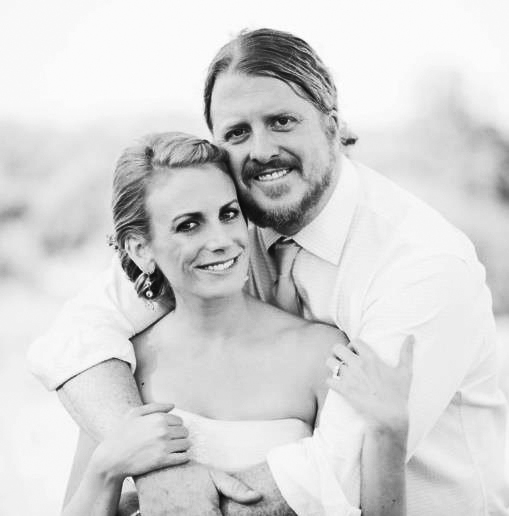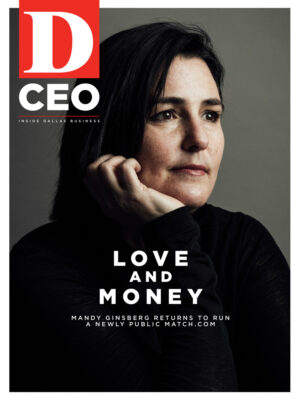After a couple of glasses of wine, Lauren Whitson took the plunge. She’d been thinking about this for a while. She couldn’t ignore the fact that the other pieces of her life were coming together nicely: She’d earned a degree, found a fulfilling career path in nonprofit work, had plenty of friends. She’d also just turned 30, and was feeling some pressure to settle down. To find someone. And she didn’t want to spend time prowling through bars or attempting to find a guy in Fort Worth whose relationship history she didn’t already know. Online dating seemed like the best option. At the very least, she figured, she’d meet some new people.
Lauren wrote a quick Match.com profile and posted four or five photos: a classic headshot and a couple more of her smiling with friends or on vacation. Then she went to bed.
“I woke up the next morning and had so many messages in my inbox that I almost immediately deleted my account,” she says. “I had crazies from states away that were like, ‘I want to marry you.’ I thought, ‘What have I done?’”
She’d received messages from men old enough to be her father, and come-ons from dudes whose only photo was a creepy bathroom selfie. In one message, a guy told her he wanted to “wash her hair and wrap her up in his hoodie.” She wasn’t exactly sure what that meant.
Lauren patiently deleted messages and tried not to think about the fact that all of these strange men were perusing her profile, sizing her up. Then she received a “wink”—the Match equivalent of a Facebook “poke”—from a web designer named Brian.
His profile expressed interests similar to hers: a love of travel, an affinity for bluegrass music festivals, subtle outdoorsy-ness. On a whim, she winked back, and he sent her a casual message suggesting drinks. He figured she was way out of his league, but, after a few more exchanges, a first date was set. Since Brian lived in Dallas and Lauren lived in Fort Worth, they met at Sherlock’s, a bar halfway between them along Interstate 30. She got lost and arrived a little late, but he was glad she showed up at all.
Brian Whitson was 36, and didn’t look like the kind of man that petite, blonde Lauren had previously imagined herself with. He’s a big guy, 6 feet 4 inches, with long red hair and a beard. He was also a former designer for Match, and was riding out the fast-dwindling days of his free membership. (Single Match employees are heavily encouraged to use the site.)
The two discovered they had more in common than the interests on their profiles. As they talked, they realized they’d even been at some of the same concerts—though Brian told her that if he’d ever seen her, he wouldn’t have had the guts to approach her. A few drinks in and feeling comfortable, Lauren revealed that she’d lost her mother to suicide. To her surprise, Brian knew how she felt: His father had recently died the same way. Both left the date feeling a connection.

That was October 2010. Things moved quickly; they were serious enough for Brian to meet her family that Christmas. The couple spent time together at her family’s 1,500-acre ranch in Sunset, Texas. Early on, Lauren asked him if he’d love her even if she didn’t have a ranch. He joked that he didn’t feel comfortable answering that.
They dated for another year and, in December 2011, they went to Cape Town, South Africa, to visit friends for the holidays. On Christmas morning, early in the hazy tranquility before the commotion, they took a scenic hike up Table Mountain. At the top, Brian asked Lauren to be his wife. She said yes.
♥♥♥

Match Group Inc. (Nasdaq: MTCH) made its stock market debut in November 2015 at a price range of $12 to $14 per share. Match’s spinoff from its parent company IAC/InterActiveCorp—IAC, controlled by billionaire Barry Diller, retains most of the Match shares and about 98 percent of the voting power—caused a management reshuffle. Former IAC CEO Greg Blatt is now chairman and CEO of the Match Group. Sam Yagan, the former Match Group chief executive (and co-founder of OkCupid), joined the Match Group board of directors. And Mandy Ginsberg, previously CEO of The Princeton Review (another Match-owned site that connects students with tutors), is now CEO of the Match Group in North America.
This isn’t Ginsberg’s first time in these offices. She was the chief executive of Match U.S. back in 2008 and held the post until switching over to the company’s tutoring affiliate in 2013. So this recent shift is a bit of a homecoming. Canaday says she keeps forgetting how much has changed since Ginsberg was last in charge. Veteran staffers expect her to be caught up overnight. But things move fast in a high-tech world, and Ginsberg will now oversee all of the U.S. brands under the Match umbrella. Match had a “zero” mobile footprint in 2008. Now, about 60 percent of its users access dating sites through their phones.
“In 2008, I took over Match. We brought a new team in, and it was a period of hyper-explosive growth,” Ginsberg says. “We bought a number of different brands and incubated brands and we went public. And now I’ve come back, so it’s been full circle.”
♥♥♥

Only a few years ago, the idea of meeting a dating partner on the Internet was the sort of thing you’d be teased about. A relationship born on the web was somehow pathetic or contrived. Today, everyone from single millennials to retired divorcées are plugging in to at least one dating site. They switch back and forth between apps and swipe through their smartphones as they wait for a cup of coffee or in line at the bank. According to a 2009-2010 survey commissioned by Match, one in five relationships begin online. The same technology that seems to disconnect people from their surroundings is now connecting them in real life. And no company is doing that better than Match.
Match Group owns no fewer than 45 different dating brands, and claims to have created 10 million relationships in the United States. There are 59 million monthly active users across its sites, and 4.7 million paid subscribers—the chief source of the company’s revenue. According to research firm IBISWorld, that means Match Group dominates the $2.4 billion dating services industry with about a 22 percent market share. IBISWorld says California-based eHarmony is No. 2, with a market share of about 14 percent.
Match, which is currently valued at more than $3 billion, reported $883.3 million in revenue in 2014, the last full year for which figures are available. That was up from $713.4 million in 2012. For the third quarter of 2015, the company reported a 19 percent rise in revenue, to $274.2. Match Group is growing so fast, in fact, that it plans to move its headquarters later this year to a larger, 73,000-square-foot space at NorthPark Central tower, formerly the headquarters of the Richards Group. (There’s also this: Match claims responsibility for the birth of 1 million babies.)
Whether you’re a baby boomer (babyboomerpeoplemeet.com) or a Mormon (LDSplanet.com) or a crazy cat lady (petpeoplemeet.com), Match wants to find you a mate. Or at least a hookup partner. Match also owns Tinder, the dating app popular with a younger demographic and known for its casual “swipe” method (swipe right on a person’s photo if you like them, left if you’re not interested). OurTime targets an older demographic, with most of its users over 50. Chemistry.com is known for its compatibility algorithm and inclusive nature, which allowed it to capitalize on the flack major competitor eHarmony caught in 2007 for not providing options for those seeking same-sex relationships.
Over time, the company acquired several other successful dating sites. Among them: niche dating service People Media (bought in 2009) and OkCupid (2011). In 2015 it paid $575 million for Plenty of Fish.
If the sheer numbers don’t underscore the scope of the company’s appeal, consider this: In the middle of all that colorful, happy chaos on the Match wall of success is a piece of paper with the words: SPACE RESERVED FOR MARTHA STEWART.
Says Canaday: “Martha signed up a few years back.”
♥♥♥
Inside Ginsberg’s office, the whiteboard on the forest-green wall is covered with the marks of someone trying to get up to speed. But Ginsberg, dark-haired and clad in a bright red dress shirt, doesn’t seem fazed. Her coffee mug reads: “Match.com—Quest for World Domination.” It’s her 10th day at her new job.
Ginsberg is a Dallas native who went to the Hockaday School. She played soccer at Berkeley and attended the Wharton School of Business at the University of Pennsylvania. When her mother was diagnosed with cancer, she came home to Dallas and took a job at a software company, where she met her husband. She’s been here ever since (even commuting to New York while working for The Princeton Review).
Ginsberg says that Match is about “changing the trajectory of someone’s life.” It’s about using technology to connect real human beings to other real human beings. The brand took off in 2010, due in part to the launch of a successful ad campaign featuring real couples on first dates.
The idea of coupling and falling in love is so inherent in who we are.
In the coming year, Ginsberg plans to work to keep Match relevant—and to figure out how to manage so many different businesses under one brand. The year will be about looking at the U.S. market as a whole. That will make it easier to organize geographically—which, not coincidentally, is how consumers think about dating.
In addition to providing dating diversity and gobbling up its competition, the most obvious ingredient in Match’s success is also the biggest: People want to fall in love. They’re not afraid to pay $20 a month to do so, or to pay extra for services that will streamline their experience or increase their chances. The money isn’t much if you happen to meet the love of your life—or even just a few interesting new people. That may be why Match scores an “F” from the Better Business Bureau, a fact that Amy Canaday shrugs off. People want to meet the love of their lives and they lash out when they fail, in her opinion. They blame the messenger. Maybe they should just try sending a few more winks.
“The idea of coupling and falling in love is so inherent in who we are, it’s not going away,” Ginsberg says. “That feeling of going on a date and thinking, ‘Oh, this is going so well’—that moment is our business.”
♥♥♥
It was October 20, 2012, and the sky was bright blue at Lauren’s family ranch. The bride clutched a bouquet of roses, succulents, and sunflowers—her late mother’s favorite. Lauren and Brian were married by a longtime friend of Brian’s late father under a rustic wooden arch decked with fall flowers. Brian had to lean down to kiss his 5-foot-3-inch bride. After the ceremony, the couple danced under fairy lights to bluegrass music.

Lauren’s dad hasn’t found his happily-ever-after yet, but he needn’t worry—the over-50 group is one of Match’s fastest-growing demographics.
Today, Brian and Lauren live comfortably in Lake Highlands. She works for Friends of the Katy Trail, and he’s a web designer for Avaya in Coppell. They have two dogs and travel whenever they get the chance, often driving the two hours out to visit the ranch where they were married. The Whitsons have also been planning the next stage of their happily-ever-after: the growth of their Match-made family. They’d like to add a baby photo to the Match success wall soon.






